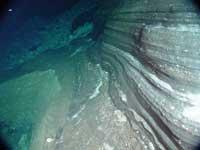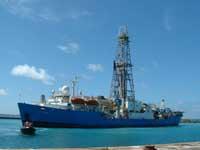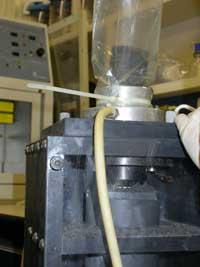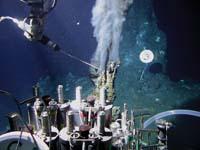Below the seabed, what? Alive
2008/07/20 Lakar Iraizoz, Oihane - Elhuyar Zientzia

It is not easy to imagine the conditions that this environment must have, since, in general, the lower it is done in the sediments, the harder the conditions are. On the one hand, the amount of organic matter that living beings need to feed is getting smaller, because sediments are getting older and therefore have been wasting food for longer. Well, the microbes they have discovered live in sediments of 111 million years.
On the other hand, the pressure to which these means are subjected is increasing. think, besides the pressure exerted by the rock, on the sediments is the Atlantic Ocean! And finally, the temperature also increases as it descends (in some areas it rises twenty degrees per kilometer that falls under the ground). The sampling area measured temperatures between 60 and 100 degrees.
In search of the limit of living beings
Scientists suspected that at that depth there were living beings. In fact, previous studies suggested that some microbes would reach between 4 and 5 kilometers from the seabed, since from there the conditions would be too harsh.

Suggest yes, but find it, so far no one found living beings more than 842 meters from the bottom of the sea. This limit was established in 2002 by the same team that made the current discovery. However, they considered that they had to check what these calculations represented and that the limit established until then was too small, that is, it seemed too much to them to say that four kilometers away were living beings and that only those up to eight hundred meters could check.
Therefore, it began to deepen into the seabed in order to check this limit. The sampling took place in the Atlantic Ocean with an excavator ship called JODIES Resolution. This ship, which was formerly used to make the holes necessary to extract oil from the sediments of the seabed, was equipped with research instruments twenty years ago and since then is used to conduct research under the seabed.

The sampling was careful, since they intended at all costs to avoid contamination of the samples taken, that is, that during their extraction no microorganisms of other means were introduced in the samples so as not to reach conclusions that were not true.
Only the material at the center of the extracted sediment fragments was analyzed, as it was the material most likely to be uncontaminated. Microbes were detected through the microscope, finding that they existed.
They also wanted to know if they were alive. They used a special dyeing method: a dye that dyes the living cells of fluorescent green colors and one that dyes the dead ones of fluorescent red. This showed that 60% of the cells found were alive. In other words, the microbes live peacefully in kilometers and a half of the sea floor. We will have to see where they mark the next limit, if they intend to do so!
Published in 7K.

Gai honi buruzko eduki gehiago
Elhuyarrek garatutako teknologia






